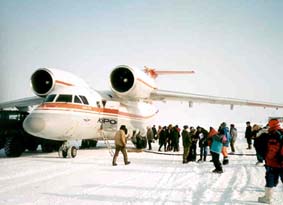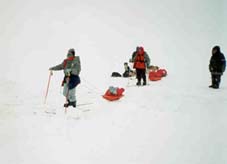|
|
|
Tourist
at the North Pole After a life full of adventure, I was deploring
a few shortcomings, such as kayaing on amazonian rïvers, or in a rnore
conventional genre, Moscow-Beijing by the TransSiberian Railway; and
finally the North Pole. First a potholer, rater a cave and sea diver,
I thereafter practised nordic skiing in such a fashion (ca. 6.000 km)
that I was fairly well prepared when I discovered ln a painphlet that
the french travel agency GNGL organized
annually a short raid (ca. one week) from 89° North up to the Pole.
I had absolutely no previous polar experience so that the GNGL raid
appeared Ilke a unique opportunity. We flew from Paris to Moscow on a regular flight. After a transfer on a very dark night to another airfleld, we boarded an Iliuchyn that brought us to Khatanga, a sniall township on the north coast of Siberia and on the same longitude as Phnom Penh. Then, the stunning Antonov 74 with its two enonnous reactors flanking a rather small cabin took us ftm Khatanga to the drifting russian pack base, via a stopover in the Severnaya Zemlya (Arctic Ocean). During the flight, accompanied by flve husky dogs, we were perched on a mountain of equipment. The pack was not the infinite frozen lake I thought lt was when I was young. From the plane it appeared fractured with hummocks (i.e. pressure ridges) and free water channels with a width of a few decirneters to one hundred rneters. Channels that can be either crossed when sufficiently frozen again, or that can be bypassed The drifting russian base named Barneo,
located at about 100-200 km from the pole, includes four large tents
for the permanent staff, four Russians and two French. We were in much
smaller tents, made for two. Some Americans, ltalians, Australians were
waiting, some of them to be parachuted over the pole, others to drift
to the pole with hot air balloons. The personal equipment was that of
the conventional three layer systerm : underwear, polar fleece, Goretex
fabric parka and pants ; plus the -45° or -65° C type Sorel
boots. After a good night under the tent we board a fairly large helicopter. We, meanlng with all our equipment, the skis, the daily rations of food, the pulkas ; the dogs and sled belonging to Sergey, a friendly Russian from Khatanga who was going to the Pole for the third time. We land at about 60-80 km from the 90°. The skis, equipped with synthetic seal skins glide very moderately. The positive side is that it allows us to strongly pull our pulkas over the numerous sastrugis (anvil shaped masses of frozen snow fîve to thirty cm high). The weather is fine, sunny. The first climbing over hummocks and the crossing of the first channel went off without too much difficulty in spite of the fact that our experience was of the zero level. The camp was pitched after about six hours of progression. Various technical problems appeared such as in the erecting of the tents, or in the working of the stoves. Boiling water was distributed. This allowed us to dissolve our variaus rations.
Back on our sids we face an obstacle : a channel in an uncertain condition of re-freezing. Two of our spanish cornpanions look for a safer passage. Meanwhile one of us, a lightweight, crosses the channel with no difficulty. The others follow, confident. After a few minutes, we face another channel, parallel to the first one and impassable. A few hundred meters to the left, same situation : idem to the right. We are forced to retrace our steps and face the dubious channel. All of us pass it, but Sergey, the last, take a run up and passes at top speed. His dogs reach the bank but slow down when seeing us close to the channel. They stop, and Serguey and his sledge are already sinking. Pulled out of the water, Sergey is wet through, up to the waist. Marc Batard (the french alpinist known as the "sprinter" of the Everest) unfolds his curious pulka-tent-canoe. Serguy now well protected changes rapidly his clothes, the minutes being numbered. Our guide then decides to stop for the night. After having eaten we squeeze, three of us the surgeon, the librarian and myself, in a tent for two, thus perfectly warm. On the 22nd of April 1997 at five in the
morning someone shouts that we are dffting close to the Pole. Our feet
ln our boots we rush to a spot six hundred rneters from the camp. There
the souvenir photos of the group are taken for prosperity.
At two in the afternoon the chopper is there. We spend a day and two nights in Bameo walting for the Tupolev. Back to Paris via Khatanga, Krasnoyarsk and Moscow with the photos in the Red Square. It's already the past, but what mernorles ! These few days were a synthesis : the ridges, the channels, the cold, the wind, the fall in the water, the sun, the dogs, the sastrugis, the stubborn stoves, the imnmensity, the ambiance, the grumblers, the adorable ones, and the reaching of the goal. This cost of this trip was 48.000 FF, all included (April 97).
|


 The
second day, Rémy, one of the sixteen participants had one of his ski
bindings broken and had thus to go on by foot. On recent lce and with
his weight less widely distributed üian with skis, the floe broke, sank
and he round himself with a boot filed with - 1,8° C water. He was
rapidly assisted; his ski socks were worked to eliminate the frost and
footwarmers were placed in his spare boots.
The
second day, Rémy, one of the sixteen participants had one of his ski
bindings broken and had thus to go on by foot. On recent lce and with
his weight less widely distributed üian with skis, the floe broke, sank
and he round himself with a boot filed with - 1,8° C water. He was
rapidly assisted; his ski socks were worked to eliminate the frost and
footwarmers were placed in his spare boots.  remain
stuck to the Khatanga time zone. The ternperature had gone down to -24°
C and the wind was reaching 40 km/ h, thus a
remain
stuck to the Khatanga time zone. The ternperature had gone down to -24°
C and the wind was reaching 40 km/ h, thus a 